Without specific mathematics instruction with accommodations, students with severe speech and physical impairments (SSPI) may face challenges in acquiring and using various math-related concepts and skills. They may have limited experience manipulating and counting objects, physically aligning numbers with quantities, seeing and writing numbers or understanding and using math-related words such as more, less, some, many, first and last. The Bridge School provides a systematic, standards-based mathematics curriculum and instruction that enables our students to solve such problems at home, at school, at work and in the community.
The broad goals in mathematics education are for students to:
At The Bridge School, math instruction builds on previous learning, promotes active student involvement, teaches rules and concepts and applies mastery teaching, problem solving and generalization. Beginning math skills in early elementary grades include learning about numbers and operations. Daily activities address one-to-one correspondence or the understanding that one set is exactly matched to another set, object discrimination and classification, quantity comparisons and seriation (ordering). This learning takes place in the context of ongoing instruction across classroom routines and curricular areas. For example, at the library there is one library book for each student or on a field trip, there is one ticket for each passenger. In an art lesson, students may select, sort or match tools, objects and materials that are the same or different or have certain properties such as color, size and shape. The daily morning meeting includes taking attendance or reviewing the calendar which provides rote counting activities, helping students learn the names of numbers and their order. Students often participate in counting and measuring activities in upright, hands-free support walkers which provide meaningful, action-based learning experiences. In elementary grades, our students learn to apply tools and techniques to determine measurements. They begin to collect data by conducting surveys of class favorites or opinions and analyze and share the results with peers and teachers using assistive technology tools and supports. Our students may use eye gaze to direct someone to distribute objects in a one-to-one manner or use a body-based signal or gesture to indicate that items are placed in the correct or incorrect location.
Given the physical limitations of our students, we are challenged with finding ways to help them learn standard order and to physically experience pairing each object with a number. Another consideration is how to give our students a perspective of the size of an object when they are viewing it from a seated position in a wheelchair. We have developed some novel approaches that incorporate the use of assistive technology to provide our students with opportunities to physically engage in learning mathematical concepts. Integrating mathematical principles into daily living activities has proven to be an effective way to ensure understanding and appreciation of many math-related concepts. All math activities support our students’ use of augmentative and alternative communication by developing vocabulary that supports “problem solving, reasoning and proof, communication, representation, and connections” (Common Core Standards Initiative for Mathematical Practice).

Savannah combines music and math as she counts up and matches one number with one key on a flat piano keyboard. The keyboard is placed directly on her wheelchair tray and Savannah is asked if each key plays the same note or how they change.
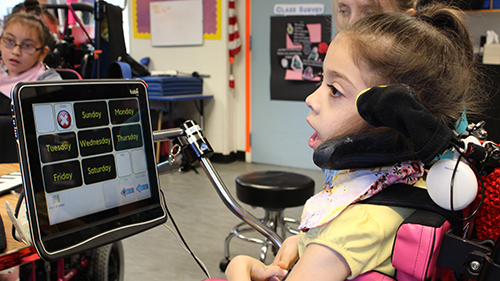
Jackie helps complete the daily calendar using her speech generating device (SGD) to name the day. She will use this same strategy to organize her own schedule and to plan and communicate her activities with her family and friends.
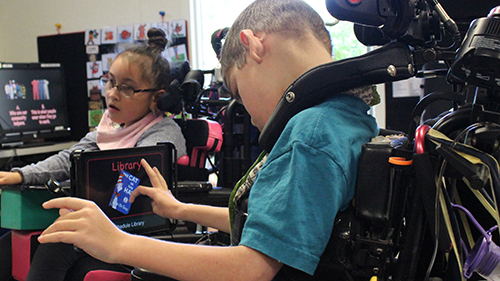
Adam is using his SGD to let his teacher know it’s time to go to the library. Learning to predict what comes next in his daily schedule is an important component in learning how to order and sequence.
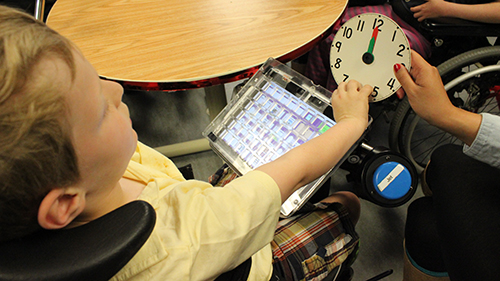
Jet is learning to tell time by the hour. His teacher holds up an analogue clock and Jet says the time out loud using his SGD.
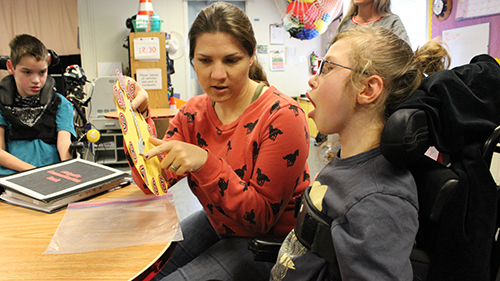
Abigail’s teacher waits for Abigail to vocalize when the little hand on the clock points to the 8. The clock was adapted following cortical visual impairment intervention guidelines. The numbers are large and outlined in a luminous color and the hands of the clock are silver.
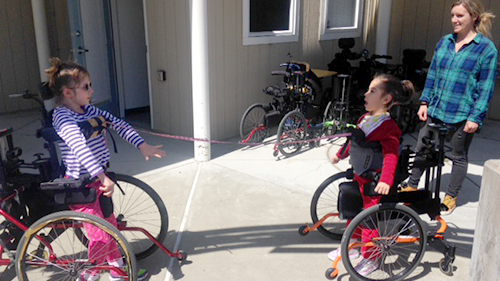
Students are using measuring tape to explore height and width, while in their hands free walkers. Abigail and Jackie decide to measure the distance between them while they’re standing still and then when they walk toward each other. When students are directing the activity, they are more invested and engaged in the activity.
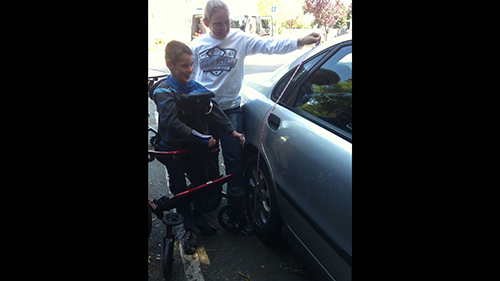
Adam walks to and then measures a car he selected in the school parking lot. Standing next to the car in his walker gives him a better size perspective than when he’s next to the car in his wheelchair. Being in his walker gives him a very different view of the height of a car.
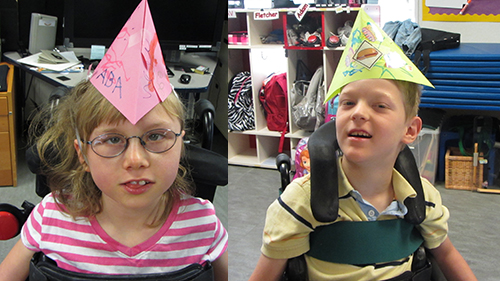
Learning the practical application of shapes, Jet and Abigail learn triangles make great party hats!
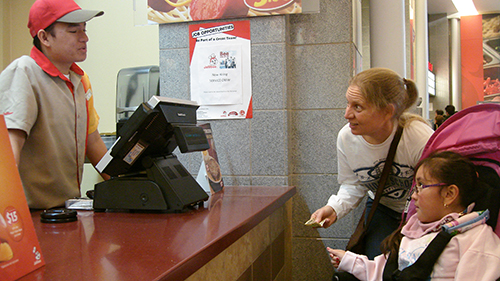
Providing real life applications for mathematical concepts is a goal during our annual fieldtrip to the shopping mall. Savannah is finding out what she can buy with her lunch allowance at the food court.
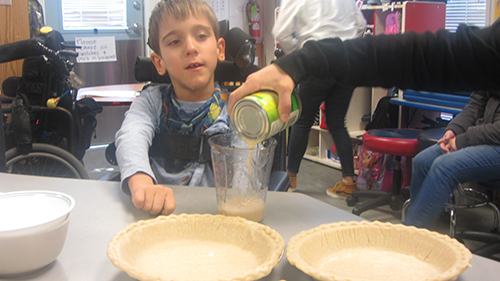
Making pies helps students practice measurement and counting skills, with a yummy outcome!
Best, S. J., Heller, K.W., and Bigge, J. L. (2010). Teaching Individuals with Physical or Multiple Disabilities. Boston: Pearson.
California Department of Education (2013). Mathematics Framework. http://www.cde.ca.gov/ci/ma/cf/draft2mathfwchapters.asp